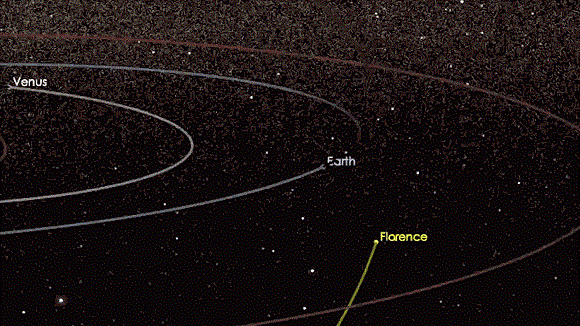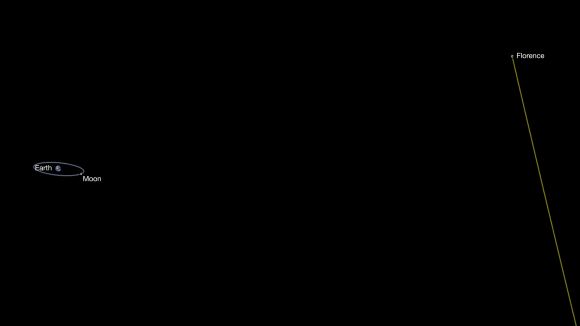Within Earth’s orbit, there are literally thousands of what are known as Near-Earth Objects (NEOs), more than fourteen thousands of which are asteroids that periodically pass close to Earth. Since the 1980s, these objects have become a growing source of interest to astronomers, due to the threat they sometimes represent. But as ongoing studies and decades of tracking the larger asteroids has shown, they usually just pass Earth by.
More importantly, it is only on very rare occasions (i.e. over the course of millions of years) that a larger asteroid will come close to colliding with Earth. For example, this September 1st, the Near-Earth Asteroid (NEA) known as 3122 Florence, will pass by Earth, but poses no danger of hitting us. Good thing too, since this Near-Earth Asteroid is one of the largest yet to be discovered, measuring about 4.4 km (2.7 mi) in diameter!
To put that in perspective, the asteroid which is thought to have killed the dinosaurs roughly 65 million years ago (aka. the Cretaceous–Paleogene extinction event) is believed to have measured 10 km (6 mi) in diameter. This impact also destroyed three-quarters of the plant and animal species on Earth, hence why organizations like NASA’s Center for Near-Earth Object Studies (CNEOS) is in he habit of tracking the larger NEAs.

Once again, NASA has determined that this particular asteroid will sail harmlessly by, passing Earth at a minimum distance of over 7 million km (4.4 million mi), or about 18 times the distance between the Earth and the Moon. As Paul Chodas – NASA’s manager of CNEOS at the Jet Propulsion Laboratory in Pasadena, California – said in a NASA press statement:
“While many known asteroids have passed by closer to Earth than Florence will on September 1, all of those were estimated to be smaller. Florence is the largest asteroid to pass by our planet this close since the NASA program to detect and track near-Earth asteroids began.”
Rather than being a threat, the flyby of this asteroid will be an opportunity for scientists to study it up close. NASA is planning on conducting radar studies of Florence using the Goldstone Solar System Radar in California, and the National Science Foundation’s (NSF) Arecibo Observatory in Peurto Rico. These studies are expected to yield more accurate data on its size, and reveal surface details at resolutions of up to 10 m (30 feet).
This asteroid was originally discovered on March 2nd, 1981, by American astronomer Schelte Bus at the Siding Spring Observatory in southwestern Australia. It was named in honor of Florence Nightingale (1820-1910) the founder of modern nursing. Measurements obtained by NASA’s Spitzer Space Telescope and the NEOWISE mission are what led to the current estimates on its size – about 4.4 km (2.7 mi) in diameter.

The upcoming flyby will be the closest this asteroid has passed to Earth since August 31st, 1890, where it passed at a distance of 6.7 million km (4.16 million mi). Between now and then, it also flew by Earth on August 29th, 1930, passing Earth at a distance of about 7.8 million km (4.87 million mi). While it will pass Earth another seven times over the course of the next 500 years, it will not be as close as it will be this September until after 2500.
For those interesting into doing a little sky watching, Florence will be brightening substantially by late August and early September. During this time, it will be visible to those using small telescopes for several nights as it moves through the constellations of Piscis Austrinus, Capricornus, Aquarius and Delphinus.
Be sure to check out these animations of Florence’s orbit and its close flyby to Earth:
https://echo.jpl.nasa.gov/asteroids/Florence/Florence_orbit.mov
https://echo.jpl.nasa.gov/asteroids/Florence/Florence_Earth_flyby.mov
Further Reading: NASA

